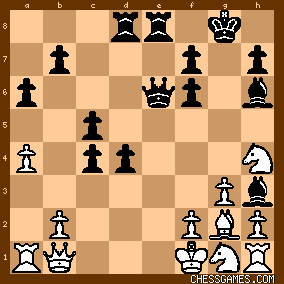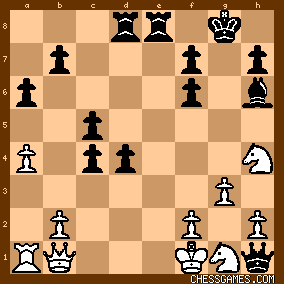|
< Earlier Kibitzing · PAGE 3 OF 3 ·
Later Kibitzing> |
Sep-28-12
 | | chrisowen: You instinctively over d3 falls to Bxh3 what about pc3 give us 22.bxh3 qc4+! he faithful to the coreestablishment smile monarch in dutifuls elevates up ply it kingg2 in spring 23...c2 ok entrance for queen too promote again small fokker f1 hoping for stalemate after immediate queening c1 amnesia me see fill i pines for instead h6 allows ground to trade light off in give 24...Qxf1+ rock recaptures ticking along short method a1s good to sweep back in dread no share the spoils c1qu at for terrific regain the piece black has devious intention ado push c5 in d4 while white troops we devolve around cornered off black at his leisure should be able to maneovre gg time really factored in unless dark froze braving calculation unfavourable to him.
<21...c3 22.Bxh3 qc4+ I wonder mitigate in heads up f1 g2 23.c2
24.qf1 qxf1+ 25.rxf1 c1 prom too 26.Rxc1 Bxc1> |
|
| Sep-28-12 | | James D Flynn: The draw agreement is very strange. Black clearly has a won game after 21....Bxg2+ 22.Kxg2 Qd5+ 23.Ngf3 d3 and Blak has only to prepare c3 via Bd2 or Re2 followed by Rc2. No need foe any clever sacrifices, |
|
| Sep-28-12 | | CHESSTTCAMPS: Black has three well advanced pawns on the queen-side for a minor piece, with white's extra piece sitting in a congested mass on the king-side. White has the annoying threat of 22.Bxh3, apparently forcing black to choose the pressure-relieving 21... Bxg2+ or the time-losing 21... Bg4. However, there is a third option that uses black's assets to maximum advantage. 21... c3!! A possibility I saw early, but initially missed the immediacy of the problem posed by the c-pawn. The Bh3 can't be taken safely: A) 22.Bxh3 Qc4+ 23.Kg2 c2 24.N1f3 cxb1+ 25.Raxb1 d3 wins. A.1) 23.Ne2 Qxe2+ 24.Kg2 c2 25.Qg1 d3 wins.
A.2) 24.Qa2 Qxa2 25.Rxa2 c1=Q wins.
A.2) 24.Qe1 Rxe1+ 25.Rxe1 c1=Q wins.
B) 22.Nxh3 Qc4+ 23.Kg1 c2 also wins a Q.
C) 22.bc Qc4+ 23.Ne2 Qxe2+ 24.Kg1 dxc3! (the pawn is still worth more than a bishop) 25.Bxh3 c2 wins. D) 22.Qd3 cxb2 23.Rb1 Bxg2+ 24.Kxg2 c4 25.Qc2 c3 and the pawn roller is crushing. E) 22.b3 Bxg2+ 23.Kxg2 d3 24.N1f3 c2 25.Qb2 Qe4 and the threat of d3-d2 decides. Time for review.... |
|
| Sep-28-12 | | GooberNumber9: Well, I got the "right" answer for once on a Friday, but I don't feel like it. Seems like 21...c3 is far superior, but I didn't see it. I thought (and still feel like) 21...Bxg2+ was a winning move - the draw mystifies me. |
|
| Sep-28-12 | | CHESSTTCAMPS: Following is a link to play the puzzle position against Crafty EGT with colors reversed: http://www.chessvideos.tv/endgame-t... Good luck! |
|
| Sep-28-12 | | M.Hassan: <CHESSTTCAMPS>
Your line A.1) does not seem to be correct.
23.......Kxe2+
24.Kg1 not Kg2
I do not think this line wins. Do you? |
|
| Sep-28-12 | | CHESSTTCAMPS: <M.Hassan> I don't think my error is here, but in overlooking the defense 24.Qf1 in the A) line. So far, I've not found a win against this defense from Crafty EGT, so I have to agree with you. |
|
| Sep-28-12 | | bachbeet: I thought of c3 also but still wasn't sure how it would end up. Then, when I saw the game continuation led to a draw, it's clear c3 was better. |
|
| Sep-28-12 | | agb2002: Black has the bishop pair and three pawns for a bishop and two knights. White threatens B(N)xh3.
Black would recover a piece with 21... Qc4+ if a black pawn were not there. The bishop on h6 can help promote the central pawns. These details suggests 21... c3, creating a GOOT position for White: A) 22.Bxh3 Qc4+ 23.Kg2 c2 24.Qf1 Qd5+ 25.N1f3 d3 followed by c2 and it seems that the passed pawns will cost White a lot of material. B) 22.Nxh3 Qc4+ looks similar to A.
C) 22.bxc3 Qc4+ 23.Ne2 Rxe2 24.Kg1 (24.Bxh3 Rb2+ and 25... Rxb1) 24... Bxg2 followed by Qxc3 - + [B+3P vs N]. D) 22.b3 Bxg2+ followed by 23... d3 and ... c2 winning material. E) 22.Qd3 cxb2 23.Rb1 Bxg2+ 24.Kxg2 c4 and Black has won another pawn and has mobilized three connected passed pawns. |
|
Sep-28-12
 | | paulalbert: Considered a lot of ideas, trying to make use of pins etc., or advance of pawns such as d3, but couldn't make anything work. Didn't even consider c3. This one was difficult; makes up for what seemed to be easier ones earlier in week. |
|
| Sep-28-12 | | Patriot: I'm stumped on this one. Taking advantage of a cross-pin with Qc6 or Qe4 looks appealing but neither works. 21...d3 22.Bxh3 Qe2+ 23.Nxe2 dxe2+ 24.Kg2 e1=Q 25.Qxe1 Rxe1 26.Rxe1 is terrible. 21...d3 22.Bxh3 Qe1+ 23.Qxe1 Rxe1+ 24.Rxe1 d2 25.Rd1 Re8 26.Nf3 and black is lost. The only thing I see is the anti-tactical 21...Bxg2+ or 21...Bg4. 21...Bd2 22.Bxh3  . . 21...Bc1 looks interesting since 22.Qxc1 Qe4 (cross-pin) 23.f3 Qd3+ 24.Kf2 Re2+ 25.Nxe2 but I think black is running out of options (and pieces). I give up! |
|
| Sep-28-12 | | Patriot: Here's what Houdini has to say at 21-ply:
New game - Houdini 1.5a x64, Blitz:4'+2" Microsoft

click for larger viewAnalysis by Houdini 1.5a x64:
1.  (-1.47): 1...c3 2.Bxh3 Qc4+ 3.Kg2 c2 4.Qf1 Qxf1+ 5.Rxf1 c1Q 6.Rxc1 Bxc1 7.Ngf3 Bxb2 8.Rb1 Bc3 9.Rxb7 d3 10.Bf5 h5 11.Rb6 d2 12.Bc2 d1Q 13.Bxd1 Rxd1 14.Rxa6 Ra1 15.Rc6 Bb4 16.Rxf6 Rxa4 17.Rf5 (-1.47): 1...c3 2.Bxh3 Qc4+ 3.Kg2 c2 4.Qf1 Qxf1+ 5.Rxf1 c1Q 6.Rxc1 Bxc1 7.Ngf3 Bxb2 8.Rb1 Bc3 9.Rxb7 d3 10.Bf5 h5 11.Rb6 d2 12.Bc2 d1Q 13.Bxd1 Rxd1 14.Rxa6 Ra1 15.Rc6 Bb4 16.Rxf6 Rxa4 17.Rf5 2. µ (-1.36): 1...Bg4 2.Bf3 Bxf3 3.Ngxf3 d3 4.Kg2 Qd5 5.Rf1 Re2 6.Qa2 f5 7.Rae1 Rde8 8.Qa1 Bd2 9.Rd1 R8e3 10.Qa3 Bb4 11.Qa1 Qe4 12.Qc1 3. µ (-1.29): 1...Bxg2+ 2.Kxg2 Qd5+ 3.Nhf3 d3 4.a5 Qc6 5.Ra3 Bd2 6.Nh3 Re2 7.Rd1 Rde8 8.Nhg1 R8e3 9.Rxd2 Rxd2 10.Qc1 Rde2 11.Qxc4 Rxb2 12.Rxd3 Rxd3 13.Qxd3 c4 14.Qc3 Rb5 15.h3 Rb3 16.Qc2 Kg7 17.h4 4.  (1.41): 1...d3 2.Bxh3 Qd5 3.Bg2 Qd7 4.Bf3 b5 5.Qa2 Bg5 6.Ng2 d2 7.Qb1 b4 8.h4 Bh6 9.h5 Qe6 10.Nh4 c3 11.Kg2 cxb2 12.Qxb2 b3 13.Rd1 (1.41): 1...d3 2.Bxh3 Qd5 3.Bg2 Qd7 4.Bf3 b5 5.Qa2 Bg5 6.Ng2 d2 7.Qb1 b4 8.h4 Bh6 9.h5 Qe6 10.Nh4 c3 11.Kg2 cxb2 12.Qxb2 b3 13.Rd1 5.  (1.74): 1...Bg5 2.Bxh3 Qc6 3.Bg2 Qe6 4.Bf3 Bxh4 5.gxh4 b5 6.axb5 axb5 7.Ne2 Qh3+ 8.Bg2 Qxh4 9.Qf5 c3 10.bxc3 d3 11.Bf3 dxe2+ 12.Bxe2 Re5 13.Rg1+ Kf8 14.Qg4 Qxg4 (1.74): 1...Bg5 2.Bxh3 Qc6 3.Bg2 Qe6 4.Bf3 Bxh4 5.gxh4 b5 6.axb5 axb5 7.Ne2 Qh3+ 8.Bg2 Qxh4 9.Qf5 c3 10.bxc3 d3 11.Bf3 dxe2+ 12.Bxe2 Re5 13.Rg1+ Kf8 14.Qg4 Qxg4 6.  (2.59): 1...Qe5 2.Bxh3 d3 3.f4 Qd5 4.Bg2 Qd7 5.Bf3 Bg7 6.Kg2 f5 7.Nh3 Bf6 8.Qa2 Bxh4 9.gxh4 Qd4 10.Rhc1 b5 11.axb5 axb5 12.Rg1 (2.59): 1...Qe5 2.Bxh3 d3 3.f4 Qd5 4.Bg2 Qd7 5.Bf3 Bg7 6.Kg2 f5 7.Nh3 Bf6 8.Qa2 Bxh4 9.gxh4 Qd4 10.Rhc1 b5 11.axb5 axb5 12.Rg1 I looked at 21...c3 also but apparently dismissed it too early. |
|
| Sep-28-12 | | QueenMe: Seems to me that 21) ... c3, with its attendant mate threat (err... make that a big-material-losing check threat) is more than enough to be have black accepting a draw like he did. Maybe they were teammates in a final, inconsequential round of play. |
|
| Sep-28-12 | | Once: <Oxspawn> you are getting better at these puzzles! |
|
| Sep-28-12 | | Helios727: If 21... c3, what happens after 22. bxc3 ? |
|
| Sep-28-12 | | LoveThatJoker: <21...c3! 22. Bxh3> [22. bxc3 Qc4+ 23. Ne2 Rxe2 (23...Qxe2+  ) 24. Kg1 Bxg2 ) 24. Kg1 Bxg2  ; 22. Nxh3? Qe2+ 23. Kg1 cxb2! 24. Ra2 Qe1+ ; 22. Nxh3? Qe2+ 23. Kg1 cxb2! 24. Ra2 Qe1+  ; 22. b3 Bxg2+ 23. Kxg2/Nxg2 d3 ; 22. b3 Bxg2+ 23. Kxg2/Nxg2 d3  ] ] <22...Qc4+ 23. Kg2>
(23. Ne2 Qxe2+ 24. Kg2 cxb2 25. Ra2 Bc1  ) )
<23...c2 24. Qf1>
(24. Qa2? Qxa2 25. Rxa2 c1=Q  ) )
<24...Qxf1+ 25. Rxf1> Best
<25...c1=Q 26. Rxc1 Bxc1 27. Ngf3> (27. Bf5 Bxb2  ) )
<27...Bxb2 28. Rb1 Bc3 29. Rxb7 d3 30. Rb1> Best
<30...d2 31. Rd1 Re1 32. Nxe1 dxe1=Q 33. Rxe1 Bxe1>  LTJ |
|
| Sep-28-12 | | Blunderdome: Many people are appending exclamation points to 21...c3, including, I guess, the admins. But can anyone show a way for white to survive after 21...Bxg2? Seems to me both moves win. |
|
| Sep-29-12 | | Abdel Irada: I'm going to pass on this one. My computer wouldn't boot up last night, and today I woke wondering if I'd caught a virus from it. In any case, thanks to the computer problem and my own sinus infection, I got to the puzzle late, and have no energy to attempt a real solution. Superficially, <21. ...c3<>> looks strong, but I have yet to find a way to defeat all the possible defenses. And on this occasion, I'm not going to try. :~/ |
|
| Sep-29-12 | | Once: <Blunderdome> I think Patriot's post answers your question. The best move does seem to be c3 but Bxg2 also gives black a small advantage. I don't think either move deserves an exclamation mark, but both should win. |
|
| Sep-29-12 | | Wang Zug: Analysis by Houdini 1.5a w32 (depth 29):
1.  (-1.78): 1...Sxg2+ 2.Kxg2 Dd5+ 3.Jgf3 d3 4.Ve1 Vxe1 5.Dxe1 d2 6.De7 d1D 7.Vxd1 Dxd1 8.Jf5 Sf8 9.Dxf6 h6 10.a5 Ve8 11.Jxh6+ Sxh6 12.Dxh6 Dd5 13.Df6 Ve2 14.Kf1 Ve4 15.Kg2 Vg4 16.Kg1 Vg6 17.Df4
2. (-1.78): 1...Sxg2+ 2.Kxg2 Dd5+ 3.Jgf3 d3 4.Ve1 Vxe1 5.Dxe1 d2 6.De7 d1D 7.Vxd1 Dxd1 8.Jf5 Sf8 9.Dxf6 h6 10.a5 Ve8 11.Jxh6+ Sxh6 12.Dxh6 Dd5 13.Df6 Ve2 14.Kf1 Ve4 15.Kg2 Vg4 16.Kg1 Vg6 17.Df4
2.  (-1.77): 1...Sg4 2.Sf3 Sxf3 3.Jgxf3 d3 4.Kg2 Dd5 5.Ve1 Vxe1 6.Dxe1 d2 7.De7 d1D 8.Vxd1 Dxd1 9.Jf5 Sf8 10.Dxf6 h6 11.a5 Ve8 12.Jxh6+ Sxh6 13.Dxh6 Dd5 14.Df6 Ve2 15.Kf1 Ve4 16.Kg2 Vg4 17.Kg1
3. (-1.77): 1...Sg4 2.Sf3 Sxf3 3.Jgxf3 d3 4.Kg2 Dd5 5.Ve1 Vxe1 6.Dxe1 d2 7.De7 d1D 8.Vxd1 Dxd1 9.Jf5 Sf8 10.Dxf6 h6 11.a5 Ve8 12.Jxh6+ Sxh6 13.Dxh6 Dd5 14.Df6 Ve2 15.Kf1 Ve4 16.Kg2 Vg4 17.Kg1
3.  (-1.65): 1...c3 2.Sxh3 Dc4+ 3.Kg2 c2 4.Df1 Dxf1+ 5.Vxf1 c1D 6.Vxc1 Sxc1 7.Jgf3 Sxb2 8.Vb1 Sc3 9.Vxb7 d3 10.Sg4 d2 11.Jxd2 Vxd2 12.Sh5 Kh8 13.Jf5 Sd4 14.Jxd4 Vxd4 15.Vc7 Vxa4 16.Sxf7 Ve5 17.f4 (-1.65): 1...c3 2.Sxh3 Dc4+ 3.Kg2 c2 4.Df1 Dxf1+ 5.Vxf1 c1D 6.Vxc1 Sxc1 7.Jgf3 Sxb2 8.Vb1 Sc3 9.Vxb7 d3 10.Sg4 d2 11.Jxd2 Vxd2 12.Sh5 Kh8 13.Jf5 Sd4 14.Jxd4 Vxd4 15.Vc7 Vxa4 16.Sxf7 Ve5 17.f4 |
|
| Sep-29-12 | | vikram2791: I have no idea why they agreed to a draw.22. Kxg2 Qe4+! 23. Kf1 Qxh1. Look at the diagram:

click for larger viewBlack is up on material and is completely on top. His c and d- pawns are close to promotion and White's position is mediocre. |
|
| Sep-29-12 | | Blunderdome: <vikram> White will play 23. Qxe4. |
|
| Sep-29-12 | | Tiggler: Looked a long time at 21... d3, but found three different white defenses. Could not see anything that works, so chose ...Bg4. |
|
| Sep-29-12 | | Tiggler: <vikram2791>
From your diagram, after 24. Nhf3 the black queen and two white knights are out of the game. That leaves white Q+R to play against 2R+B+3p. Not all that clear because the N on f3 can help against the d-pawn. |
|
| Sep-30-12 | | Abdel Irada: <vikram2791>: Two observations: (1) As <Blunderdome> suggests, to avoid an exchange of queens, Black would have to play 22. ...♕d5†. (2) There is absolutely no reason why White can't interpose with 23. ♘gf3 (or, if he prefers, 23. ♘hf3). |
|
 |
 |
|
< Earlier Kibitzing · PAGE 3 OF 3 ·
Later Kibitzing> |





